Introduction
Benghal dayflower is listed among the world’s worst weeds, affecting over 25 crops in 29 countries (Holm et al. 1977). Benghal dayflower has many characteristics that make it a very troublesome weed in Florida landscapes, nurseries, and other agricultural production areas. It was first recorded in Florida in 1928 and was designated as a legally noxious weed by the USDA in 1983 (Faden 1993). Due to its status as a legally noxious weed, presence of Benghal dayflower on nursery property can lead to quarantines, so identification and management is critical for nurseries. This article is written for green industry professionals and others to aid in the identification and management of Benghal dayflower in and around ornamental plants.
Species Description
Class
Monocot
Family
Commelinaceae—Spiderwort family
Other Common Names
Tropical spiderwort, jio, and Indian dayflower
Life Span
Perennial herb but can grow as an annual in more temperate climates.
Habitat
Benghal dayflower can grow in a wide variety of soil types but is most common and problematic in areas with moist and fertile soil. Benghal dayflower is usually not an issue in container-grown plants. In nurseries, it can be especially problematic in irrigation ditch banks and in areas that are irrigated. It can form dense stands in landscape beds, agricultural fields, roadsides, and other disturbed sites. It grows best in full sun but can also grow in shaded areas and is a common issue in shaded cut-foliage production areas and ferneries.
Distribution
Benghal dayflower is native to Africa and tropical Asia. In the United States, it is found in many southeastern states and has been listed as a noxious weed by nine states, including Florida (USDA-NRCS 2019). Benghal dayflower has been found and vouchered in over 30 counties, primarily in north and central Florida (Wunderlin et al. 2020). It is also a troublesome weed in the eastern and southern African countries.
Growth Habit
Benghal dayflower is a creeping perennial but may grow as an annual in more temperate climates of the United States. Stems are fleshy, light green in color, and readily root along the nodes on the stems. Stems can grow upright (erect) or semierect and grow up to a height of 4 to over 12 inches (Figure 1).
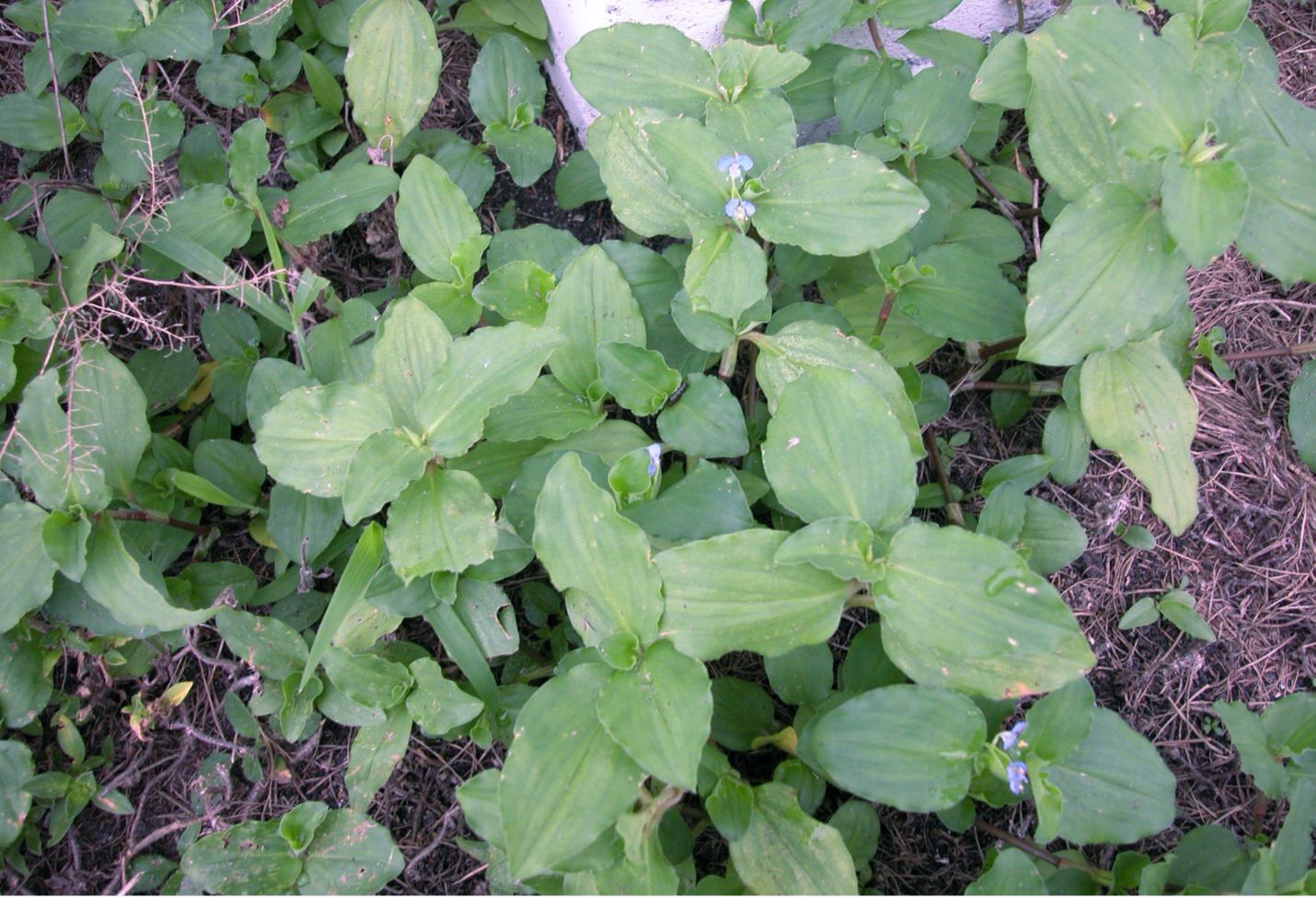
Credit: Annette Chandler, UF/IFAS
Seedling
Benghal dayflower germinates during the late spring and summer months, most commonly in June or July in Florida (Sabila et al. 2012). Young leaves are ovate (egg-shaped), grow up to 1 to 2 inches in length, and usually have hairs (pubescence) on the leaves and petioles (Figure 2). Compared to other dayflower species (Commelina spp.), the young leaves of Benghal dayflower are much shorter and wider (Webster et al. 2005).
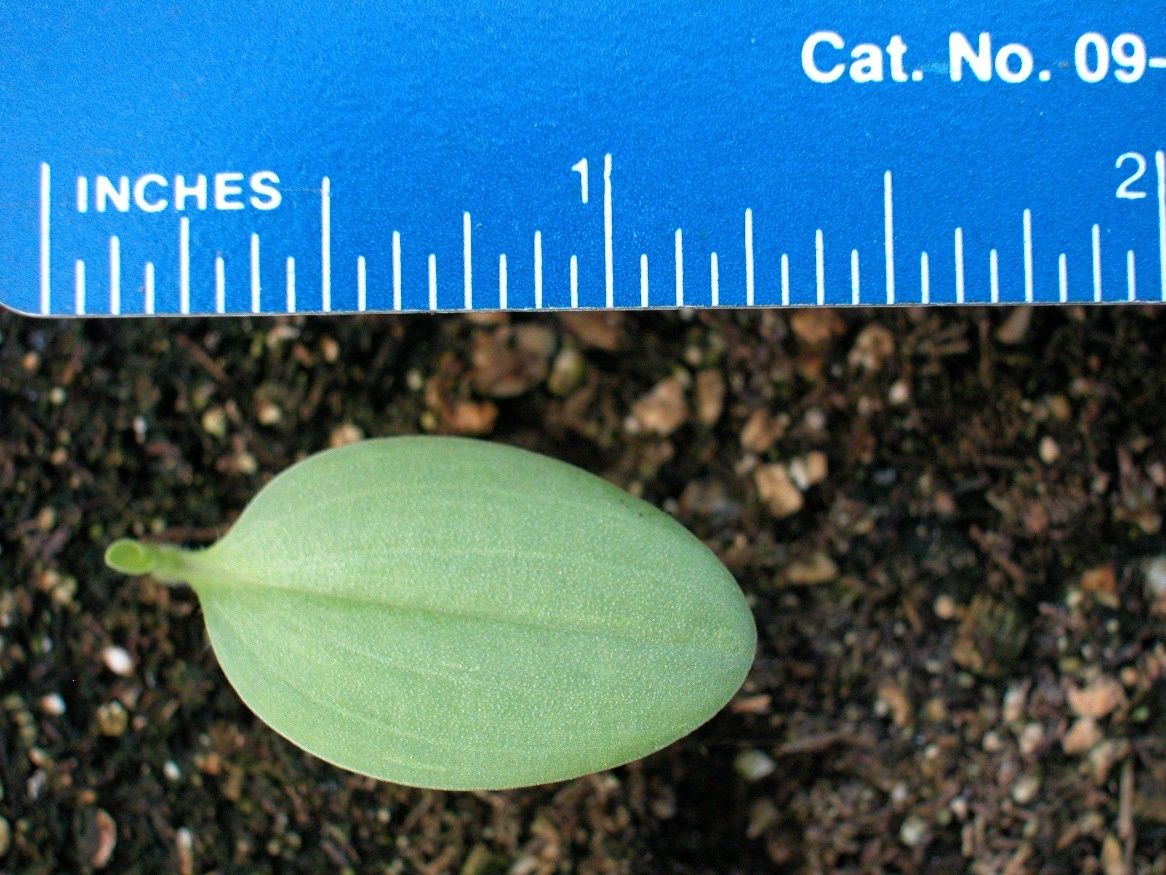
Credit: Annette Chandler, UF/IFAS
Shoots
Stems are light green in color, succulent, round, and covered with fine hairs (pubescence) on the upper and lower leaf surface. The stems may climb if supported, or they may creep along the ground and root along the nodes on stems. The leaves are ovate to triangular-ovate (egg-like) in shape and almost two to three times longer than they are wide (Webster et al. 2005). The leaf blades have entire margin (no teeth or serrations) and parallel leaf veins (Figure 3). The leaf sheaths have red or white hairs at the tip of the sheath, which is a key identification characteristic of Benghal dayflower compared with other dayflower species (Figure 4).
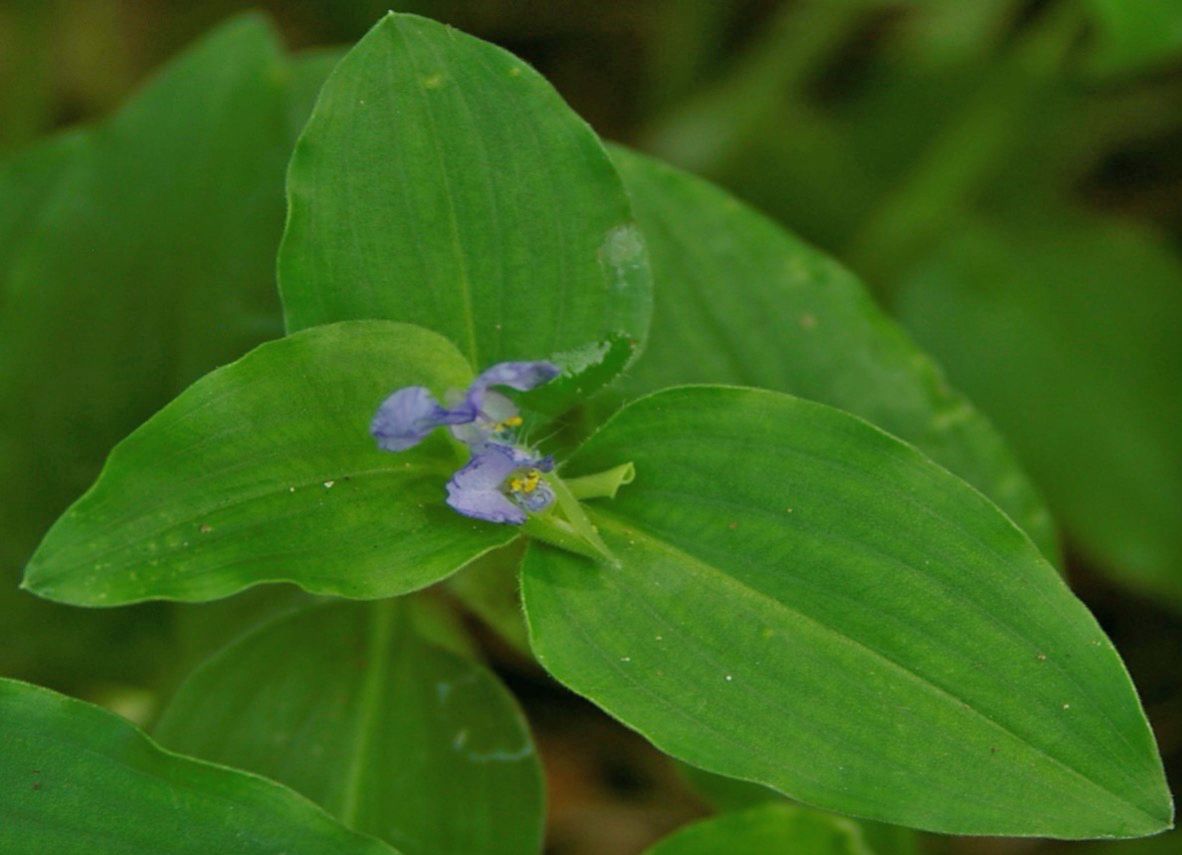
Credit: Annette Chandler, UF/IFAS
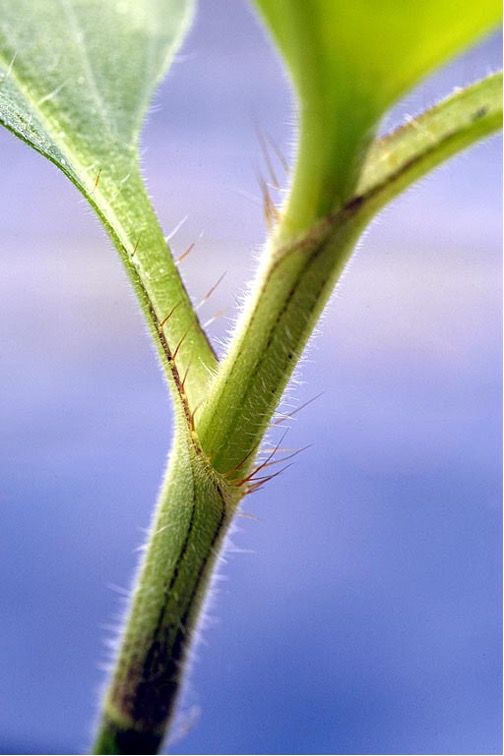
Credit: Herb Pilcher, USDA Agricultural Research Service, Bugwood.org
Roots
Benghal dayflower has a thick fibrous root system with shallow rhizomes (Figure 5). It produces underground flowers that look like swollen nodes (Ferrell et al. 2004).
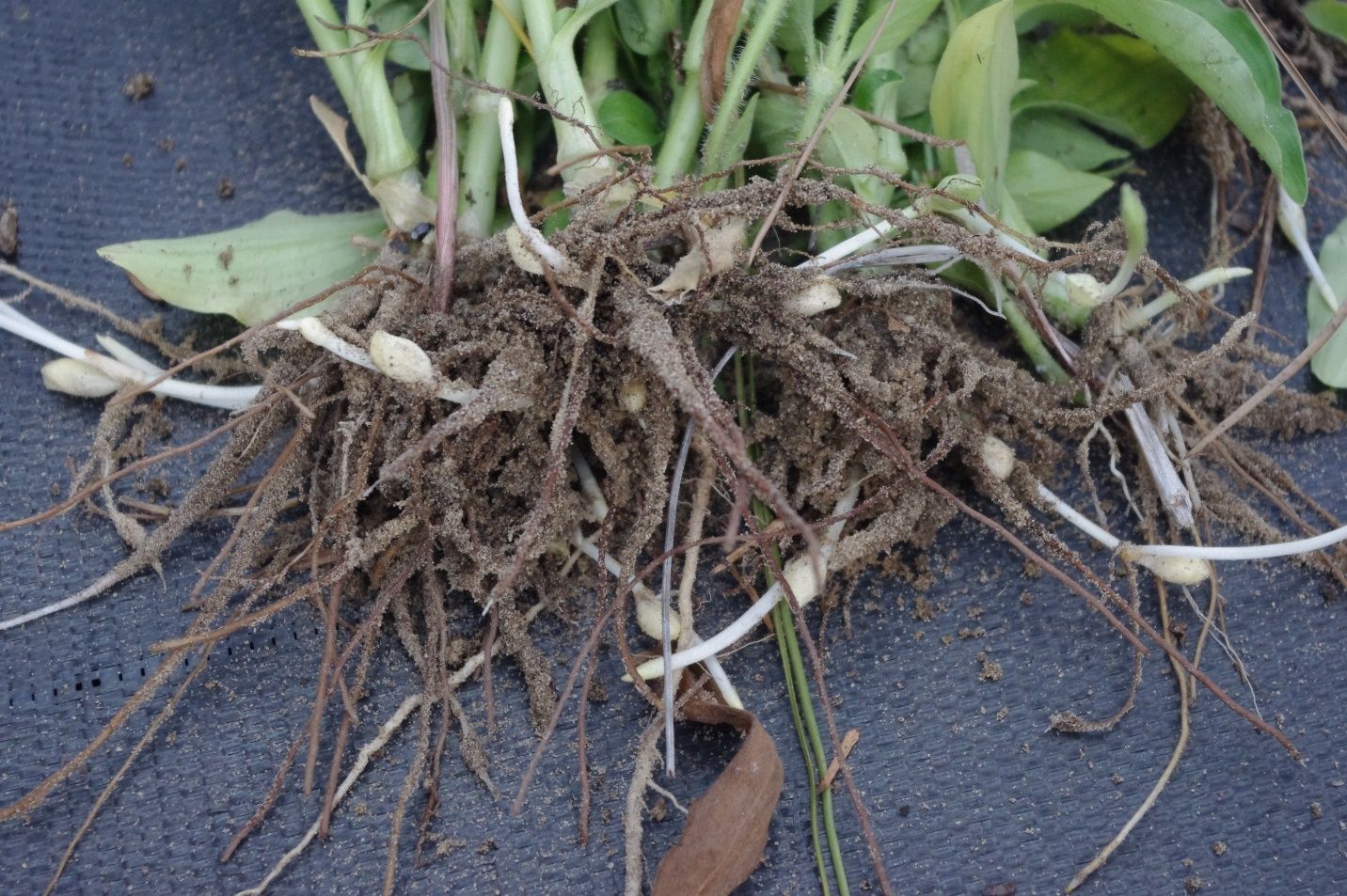
Credit: Annette Chandler, UF/IFAS
Inflorescence
Benghal dayflower has a unique ability to produce both aerial (aboveground) (Figure 6) and underground flowers. The aerial flowers are open flowers, while the underground flowers do not open and develop on rhizomes (Figure 7). Aerial flowers have three petals; the upper two petals are blue or lilac in color, and the lower petal is lighter blue or white. The flowers are produced in leaf bracts, often in clusters, are funnel-shaped, and are fused by two sides. The flowers are 0.4 to 0.8 inch long and 0.4 to 0.6 inch wide. The plant is described as dayflower because the flower of this species opens early in the morning and wilts by midday. The flowers lack nectar and may be either insect pollinated or self-pollinated.
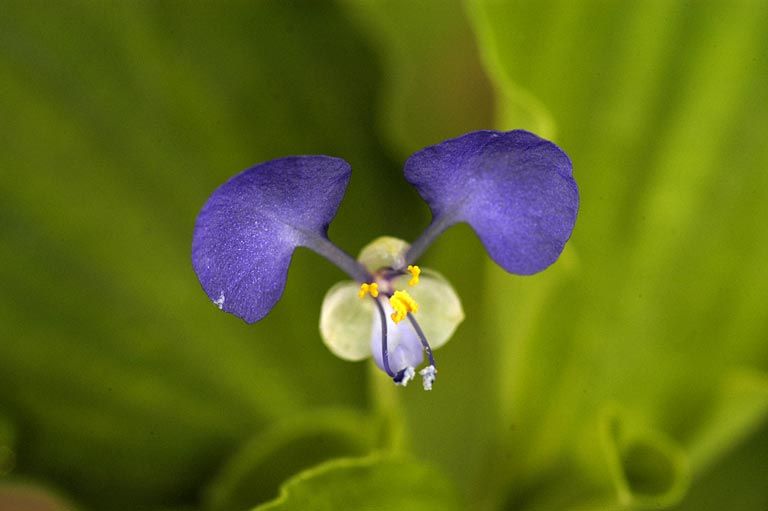
Credit: Herb Pilcher, USDA Agricultural Research Service, Bugwood.org

Credit: Annette Chandler, UF/IFAS
Fruit and Seeds
The aboveground fruit of Benghal dayflower is a pear-shaped capsule, 0.1 inch to 0.2 inch in length, and contains five seeds that are released as the fruit matures. This species also produces underground fruit consisting of three seeds that remain viable longer than the aerial ones. The seeds are brownish-black in color, are more rectangular in shape, and have a netted exterior (Figure 8).
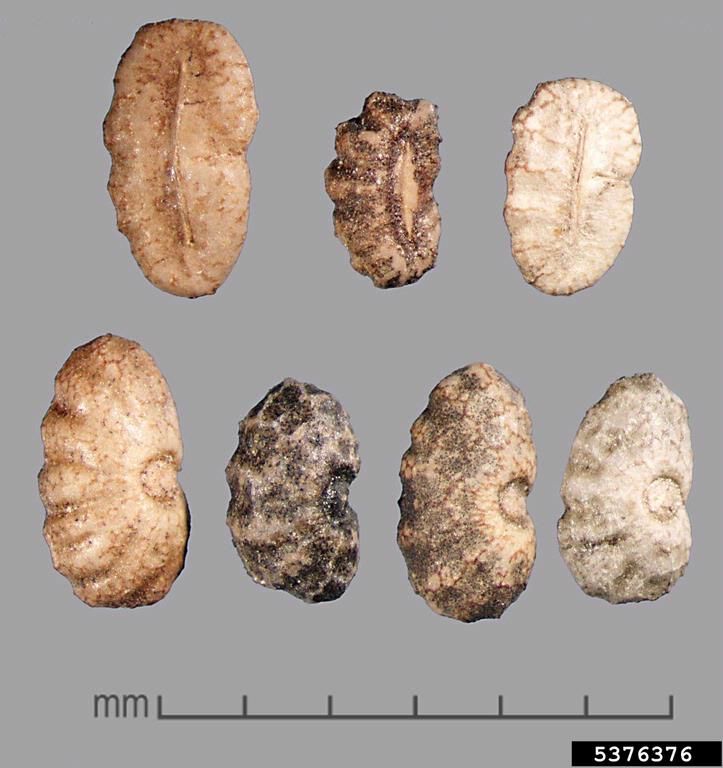
Credit: Julia Scher, Federal Noxious Weeds Disseminules, USDA APHIS PPQ, Bugwood.org
Similar Species
Virginia dayflower (Commelina virginica) can be confused with Benghal dayflower because it may have red or white hairs at the tip of leaf sheaths. However, the leaf blades of Virginia dayflower are narrower and four to six times longer than they are wide, while Benghal dayflower has much wider leaves. Spreading dayflower (Commelina diffusa) is native to the United States and is one of the most commonly found Commelina species in Florida (CABI 2019). Spreading dayflower has blue petals, but it has narrow leaves and smooth seeds. In general, Benghal dayflower will have lighter-blue flowers compared with other common dayflower species. The Florida Plant Atlas (https://plantatlas.usf.edu) contains photos of all Commelina species found in Florida and can serve as an excellent identification tool to decipher between different Commelina species.
Plant Biology
The optimum temperature for germination of aerial seeds ranges from 65°F to 80°F, and for underground seeds, from 70°F to 82°F. The underground seeds tend to germinate more rapidly than the aerial seeds. The seeds may have inherent dormancy due to an impermeable seed coat, but germination will occur after the seed is scarified over time. Each plant can produce as many as 1,600 seeds. Benghal dayflower spreads via seed, but it also spreads aggressively through vegetative growth as it roots along the nodes of stems, produces rhizomes, and can regrow from stem fragments. Stem fragments can quickly root and begin regrowing in wet soils, and they can remain viable for several weeks in dry conditions before drying out and desiccating.
Management
In addition to being classified as a noxious weed in Florida, Benghal dayflower is a federally noxious weed. The “noxious” designation is a legal classification meaning that “it is unlawful to introduce, multiply, possess, move, or release” any part of the plant (Stamps 2011). Because Benghal dayflower is a federally and state-regulated species, presence of the weed at a nursery can lead to quarantine, thereby preventing the shipment of plants to customers. Employees should be trained to scout for this weed and know how to prevent its spread.
Physical and Cultural Control
Early detection and eradication are critical for controlling Benghal dayflower. Hand removal is possible for very small infestations, but it is important that the entire plant, including roots and underground flowers, are removed and disposed of, which is not feasible in most situations. Mechanical methods such as hand hoeing and frequent low mowing may provide some suppression, but they are usually not very effective because broken stems have the ability to regenerate into new plants. Application of mulch at a depth of 2 to 4 inches can help prevent establishment from seed, but this method is also not entirely effective in most cases.
Chemical Control
Postemergence Herbicides
Postemergence control of large, established plants is very difficult and will likely require multiple applications. Glyphosate can control very small seedlings (less than 2 inches tall), but the plant is notoriously tolerant to glyphosate applications when mature. Other postemergence herbicides that have shown some degree of efficacy on Benghal dayflower include 2,4-D, bentazon (Basagran® T/O), glufosinate (Finale®), diquat (Reward®), and pelargonic acid (Scythe®), depending on growth stage. 2,4-D is not labeled for use in close proximity to ornamentals but could be used in noncrop areas and fence lines of nurseries. Regardless of the herbicide that is chosen, multiple applications will likely be needed for control of mature plants, along with the addition of a preemergence herbicide to prevent reinfestation from seed.
Preemergence Herbicides
Several preemergence herbicides can provide suppression of Benghal dayflower, but of the options labeled for use in nurseries and landscapes, S-metolachlor (Pennant Magnum®), indaziflam (Marengo® for nurseries or Specticle® for landscapes), and flumioxazin (Broadstar® and SureGuard®) have provided the most consistently effective results in nursery research trials at the University of Florida. Pennant Magnum® is labeled for over-the-top application to many different ornamental plants, while spray-applied formulations of indaziflam and flumioxazin must be applied as a directed application avoiding plant foliage. Other herbicides that have provided some control or suppression include dimethenamid-P (Tower® and as a component of FreeHand®) and simazine (Princep®). Of these options, all are spray-applied formulations with the exception of Broadstar®, FreeHand®, and granular formulations of Marengo® and Specticle® (both spray-applied and granular formulations are available for these herbicides). Because the best results are usually achieved by combining a pre- and postemergence herbicide, the spray-applied options listed here could be mixed with glyphosate or another labeled postemergence herbicide to improve control, reduce reinfestation from seed, and provide better long-term control.
References
CAB International (CABI). 2019. “Commelina benghalensis (Wandering Jew).” Accessed 3 April 2020. https://www.cabi.org/isc/datasheet/14977
Faden, R. B. 1993. “The Misconstrued and Rare Species of Commelina (Commelinaceae) in the Eastern United States.” Ann. Missouri Bot. Garden 80:208–218. https://doi.org/10.2307/2399824
Ferrell, J. A., G. E. MacDonald, and R. Leon. “Benghal Dayflower (Commelina benghalensis, L.) Identification and Control.” EDIS 2020 (4). https://doi.org/10.32473/edis-ag230-2019
Holm, L. R., D. L. Plucknett, J. V. Panco, and J. P. Herberger. 1977. The World's Worst Weeds: Distribution and Biology. Honolulu: University Press of Hawaii.
Sabila, M. H., T. L. Grey, T. M. Webster, W. K. Vencill, and D. G. Shilling. 2012. “Evaluation of Factors That Influence Benghal Dayflower (Commelina benghalensis) Seed Germination and Emergence.” Weed Sci. 60:75–80. https://doi.org/10.1614/WS-D-11-00064.1
Stamps, R. 2011. “Prevention, Early Detection, and Eradication of Benghal Dayflower in Field Nurseries.” EDIS 2011 (5/6). https://journals.flvc.org/edis/article/view/119299
USDA-NRCS. 2020. “Plants Profile for Commelina benghalensis L. (jio).” Accessed 3 April 2020. https://plants.usda.gov/core/profile?symbol=COBE2
Webster, T. M., M. G. Burton., A. S. Culpepper., A. C. York., and E. P. Prostko. 2005. “Tropical Spiderwort (Commelina benghalensis): A Tropical Invader Threatens Agroecosystems of the Southern United States.” Weed Technol. 19 (3): 501–508. https://doi.org/10.1614/WT-04-234R.1
Wunderlin, R. P., B. F. Hansen, A. R. Franck, and F. B. Essig. 2020. Atlas of Florida Plants. Accessed 2 April 2020. http://florida.plantatlas.usf.edu/